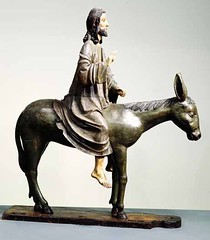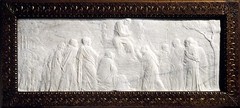By Stuart Frost
What does Easter mean to you? What images and memories does it bring to mind? For many people I’m sure it is bound up with long Bank Holiday weekends spent with family and visiting relatives. Across the length and breadth of the country there is also widespread over-indulgence in the consumption of chocolate eggs and rabbits. I usually travel back to the north-east to visit my family, although sadly its been a long time since any of them bought me an Easter egg. The religious significance of Easter is increasingly overlooked in popular culture although the forthcoming BBC drama will help redress the balance.
 Easter is the most important and oldest festival in the Christian calendar. Christianity has been the most enduring subject in western art for almost two thousand years. Therefore it isn’t surprising that art related to Easter is well represented in many museum collections, and the V&A is no exception. The central elements of the Easter story are the betrayal of Jesus, his suffering and death on the cross, his resurrection and finaly his ascension to heaven. The events which are remembered during Easter are known from the four Gospel accounts of Matthew, Mark, Luke and John.
Easter is the most important and oldest festival in the Christian calendar. Christianity has been the most enduring subject in western art for almost two thousand years. Therefore it isn’t surprising that art related to Easter is well represented in many museum collections, and the V&A is no exception. The central elements of the Easter story are the betrayal of Jesus, his suffering and death on the cross, his resurrection and finaly his ascension to heaven. The events which are remembered during Easter are known from the four Gospel accounts of Matthew, Mark, Luke and John.
Holy Week, the week leading up to Easter, begins on Palm Sunday when Christ’s entry into Jerusalem on an ass is remembered. I could have picked from any number of objects to illustrate this blog entry. The Palmesel figure (Christ on an Ass) has always been one of my favourite objects. The V&A’s Palmesel no longer has the four wheels it once had which allowed it be pulled along as part of Palm Sunday processions. Click on the object to find out more about it.
Events associated with the events leading up to the Crucifixion, like the Last Supper, the Agony in the Garden, Christ’s Betrayal by Judas and the Trial of Christ have all been represented in art, although some scenes were represented more frequently than others. The belief that Jesus was the son of God, that he was crucified and died upon the Cross is absolutely fundamental to all Christians. The Gospels tell us that Christ’s body was placed in a tomb late on Friday. They also tell us that on the Sunday Jesus rose from the dead. The belief in the resurrection of Jesus is another keystone of Christianity.
Christ’s last appearance on earth and his departure to Heaven is known as the Ascension. The scene was a challenging one for artists to depict convincingly, and there are several examples in the V&A’s collections where Christ appears to have taken off rather like a rocket with only the lower part of his legs visible in the picture frame. The depiction that I’ve chosen to use here is one of the more innovative in several significant ways.
 The sculpture is known as The Ascension with Christ Giving the Keys to St Peter and was created by the great Florentine artist, Donatello. The relief combines two events which actually occurred at different times and the subtlety of the carving seems to lend the Ascension a more convincing or realistic quality than most artists achieved.
The sculpture is known as The Ascension with Christ Giving the Keys to St Peter and was created by the great Florentine artist, Donatello. The relief combines two events which actually occurred at different times and the subtlety of the carving seems to lend the Ascension a more convincing or realistic quality than most artists achieved.
It can be fascinating to compare to different approaches to the same subject. If you’d like to do that, or if you simply like to see more examples of objects from the medieval and Renaissance collections, visit Search the Collections on the V&A’s website and enter an appropriate search term.